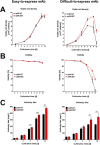miRNA engineering of CHO cells facilitates production of difficult-to-express proteins and increases success in cell line development
- PMID: 28262952
- PMCID: PMC6084326
- DOI: 10.1002/bit.26280
miRNA engineering of CHO cells facilitates production of difficult-to-express proteins and increases success in cell line development
Abstract
In recent years, coherent with growing biologics portfolios also the number of complex and thus difficult-to-express (DTE) therapeutic proteins has increased considerably. DTE proteins challenge bioprocess development and can include various therapeutic protein formats such as monoclonal antibodies (mAbs), multi-specific affinity scaffolds (e.g., bispecific antibodies), cytokines, or fusion proteins. Hence, the availability of robust and versatile Chinese hamster ovary (CHO) host cell factories is fundamental for high-yielding bioprocesses. MicroRNAs (miRNAs) have emerged as potent cell engineering tools to improve process performance of CHO manufacturing cell lines. However, there has not been any report demonstrating the impact of beneficial miRNAs on industrial cell line development (CLD) yet. To address this question, we established novel CHO host cells constitutively expressing a pro-productive miRNA: miR-557. Novel host cells were tested in two independent CLD campaigns using two different mAb candidates including a normal as well as a DTE antibody. Presence of miR-557 significantly enhanced each process step during CLD in a product independent manner. Stable expression of miR-557 increased the probability to identify high-producing cell clones. Furthermore, production cell lines derived from miR-557 expressing host cells exhibited significantly increased final product yields in fed-batch cultivation processes without compromising product quality. Strikingly, cells co-expressing miR-557 and a DTE antibody achieved a twofold increase in product titer compared to clones co-expressing a negative control miRNA. Thus, host cell engineering using miRNAs represents a promising tool to overcome limitations in industrial CLD especially with regard to DTE proteins. Biotechnol. Bioeng. 2017;114: 1495-1510. © 2017 Wiley Periodicals, Inc.
Keywords: Chinese hamster ovary (CHO) cells; cell engineering; difficult-to-express proteins; miR-557; microRNA; monoclonal antibody.
© 2017 Wiley Periodicals, Inc.
Figures









Similar articles
-
miR-143 targets MAPK7 in CHO cells and induces a hyperproductive phenotype to enhance production of difficult-to-express proteins.Biotechnol Prog. 2017 Jul;33(4):1046-1058. doi: 10.1002/btpr.2475. Epub 2017 Apr 21. Biotechnol Prog. 2017. PMID: 28371547
-
Inhibition of endogenous miR-23a/miR-377 in CHO cells enhances difficult-to-express recombinant lysosomal sulfatase activity.Biotechnol Prog. 2020 May;36(3):e2974. doi: 10.1002/btpr.2974. Epub 2020 Feb 11. Biotechnol Prog. 2020. PMID: 31990124
-
ATF6β-based fine-tuning of the unfolded protein response enhances therapeutic antibody productivity of Chinese hamster ovary cells.Biotechnol Bioeng. 2017 Jun;114(6):1310-1318. doi: 10.1002/bit.26263. Biotechnol Bioeng. 2017. PMID: 28165157
-
Assessment of cell engineering strategies for improved therapeutic protein production in CHO cells.Biotechnol J. 2008 May;3(5):624-30. doi: 10.1002/biot.200700249. Biotechnol J. 2008. PMID: 18293320 Review.
-
The art of CHO cell engineering: A comprehensive retrospect and future perspectives.Biotechnol Adv. 2015 Dec;33(8):1878-96. doi: 10.1016/j.biotechadv.2015.10.015. Epub 2015 Oct 31. Biotechnol Adv. 2015. PMID: 26523782 Review.
Cited by
-
Evaluation of "Difficult-to-Express" Monoclonal Antibodies in a CHO-Based Hybrid Site-Specific Integration System Under Industrially Relevant Conditions.Biotechnol J. 2025 Aug;20(8):e70102. doi: 10.1002/biot.70102. Biotechnol J. 2025. PMID: 40820400 Free PMC article.
-
Methods for Using Small Non-Coding RNAs to Improve Recombinant Protein Expression in Mammalian Cells.Genes (Basel). 2018 Jan 9;9(1):25. doi: 10.3390/genes9010025. Genes (Basel). 2018. PMID: 29315258 Free PMC article. Review.
-
Recent developments in miRNA based recombinant protein expression in CHO.Biotechnol Lett. 2022 Jun;44(5-6):671-681. doi: 10.1007/s10529-022-03250-1. Epub 2022 May 4. Biotechnol Lett. 2022. PMID: 35507207 Review.
-
Stable overexpression of native and artificial miRNAs for the production of differentially fucosylated antibodies in CHO cells.Eng Life Sci. 2024 Apr 1;24(6):2300234. doi: 10.1002/elsc.202300234. eCollection 2024 Jun. Eng Life Sci. 2024. PMID: 38845814 Free PMC article.
-
The Effect of microRNA on the Production of Recombinant Protein in CHO Cells and its Mechanism.Front Bioeng Biotechnol. 2022 Mar 21;10:832065. doi: 10.3389/fbioe.2022.832065. eCollection 2022. Front Bioeng Biotechnol. 2022. PMID: 35387297 Free PMC article. Review.
References
-
- Barron N, Kumar N, Sanchez N, Doolan P, Clarke C, Meleady P, O'Sullivan F, Clynes M. 2011a. Engineering CHO cell growth and recombinant protein productivity by overexpression of miR‐7. J Biotechnol 151(2):204–211. - PubMed
-
- Barron N, Sanchez N, Kelly P, Clynes M. 2011b. MicroRNAs: Tiny targets for engineering CHO cell phenotypes? Biotechnol Lett 33(1):11–21. - PubMed
-
- Bentley KJ, Gewert R, Harris WJ. 1998. Differential efficiency of expression of humanized antibodies in transient transfected mammalian cells. Hybridoma 17(6):559–567. - PubMed
-
- Bertschinger M, Backliwal G, Schertenleib A, Jordan M, Hacker DL, Wurm FM. 2006. Disassembly of polyethylenimine‐DNA particles in vitro: Implications for polyethylenimine‐mediated DNA delivery. J Control Release 116(1):96–104. - PubMed
Publication types
MeSH terms
Substances
LinkOut - more resources
Full Text Sources
Other Literature Sources

